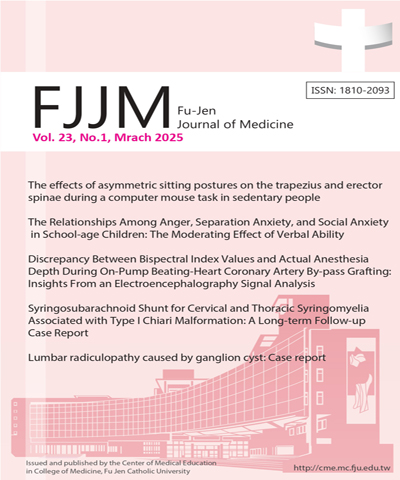
輔仁醫學期刊/Fu-Jen Journal of Medicine
輔仁大學醫學院,正常發行
選擇卷期
- 期刊
Introduction: Despite the increased awareness of needle sticks and sharps injuries and the development of safety needles, these injuries continue to occur not infrequently in a hospital setting. The purpose of the study was to critically examine these incidences and to identify risk factors associated with them. Methods: We analyzed sharps injuries occurred between 2016 and 2020 in a tertiary medical center in Taiwan. We compared those that occurred in the operating rooms (OR) with those that occurred outside the OR. The demographics of the health care workers injured, the offending objects, and the mechanisms of injury were compared between two groups of patients. Significant level was determined when p<0.05. Results: Among 157 hospital workers injured during the study period, the group of workers most commonly injured was nurses (56.0%), followed by physicians and surgeons (37.6%). The majority of those injured had a working experience of fewer than three years (73.2%, 115/157). Injuries that occurred outside the OR were self-inflicted due to the inappropriate handling of needled syringes. In comparison, 21 (41.2%, 21/51) of injuries in the OR were inflicted by operating surgeons. Among them, 15 (71.4%) were due to inappropriate transfer of surgical sharps. Conclusions: Most sharps injuries that occurred in the OR were due to human factors and were preventable. Greater effort is needed to create a safer working environment in the OR through education of hospital personnel, development of stringent OR policies for handing of surgical instruments, and critical review of every incidence of injury.
- 期刊
Objective: To evaluate on the factors related to the willingness of nurses to take care of emerging infectious diseases in designated emergency hospitals in Taipei. Methods: Designed for a cross-sectional study, a structured questionnaire survey was conducted on a total of 255 clinical nursing staffs who had been practicing for three months in a designated (regional) hospital in Taipei from July to August 2021, including demographic attributes and nursing staff The professional commitment scale, self-efficacy scale, care attitude scale, and willingness to care were analyzed by single factor variance analysis, correlation coefficient and regression. Results: The average score of nursing staff's willingness to care for emerging infectious diseases was 6.7 (standard deviation 2.55), which was statistically significantly different from their work units and whether they had participated in practical training courses; while nurses' professional commitment and willingness to care (r = 0.26, p<.01), self-efficacy and willingness to care (r = 0.20, p<.01), behavioral beliefs and willingness to care (r =0.30, p<.01) in care attitudes, results in care attitude Both evaluation and willingness to care (r =0 .27, p<.01) showed a low degree of positive correlation. Based on the analysis results, the behavioral belief dimensions of work unit, professional commitment, and care attitude after controlling for the demographic changes can explain 34.2% of the total variation of the study subjects' willingness and all reach statistically significant differences. Conclusion: More than 60% of nursing staff have the willingness to take care, but the study found that their professional commitment scale average is low as 3.34 (by Liker's method). Nowadays, the medical and nursing environment is changing rapidly. The hospital is facing the problem of health insurance payment and nursing staff turnover or not wanting to engage in nursing work after graduation. The study found that job satisfaction and professional commitment are positively correlated, and the scores of job satisfaction and professional commitment also imply the predictability of nursing staff to leave the organization or professional workplace. In view of the current generation's emphasis on belonging and the desire to be valued, nursing staff are actively provided with space and opportunities for growth and are given appropriate motivation and support environment to enhance their loyalty and stability in line with their performance, which will encourage nursing staff to continue to work hard for the nursing profession.
- 期刊
Intradiploic epidermoid cysts are uncommon, slow-growing, benign tumors, accounting for approximately 1% of intracranial tumors. They can be congenital or acquired; most of them are located intradurally and rarely in the scalp. These lesions usually manifest as painless, gradually enlarging masses over years or decades. They are clinically and radiographically difficult to differentiate from other calvarial lesions. Accurate radiological assessment and complete surgical excision of the lesion and its capsule play a crucial role in ensuring favorable long-term outcomes. We present a case of a young female diagnosed with an epidermoid cyst in the right temporal bone who underwent complete and successful surgical treatment. A complete imaging study was obtained including X-rays and computed tomography and magnetic resonance imaging scans, which demonstrated pathognomonic findings of an epidermoid cyst. We review the relevant literature, pathogenesis, radiographic characteristics, and diagnosis of the epidermoid cysts.
- 期刊
Trans-scaphoid perilunate fracture combined with distal radioulnar joint dislocation is a relatively rare wrist trauma condition and often missed in emergency setting. Traditional wrist anterior posterior and lateral Views X-ray are usually sufficient for screening writ injuries in emergency room, but occult bony lesions like these were occasionally missed out. Adjunct X-ray check with wrist navicular view would help tremendously in filling the gap.

